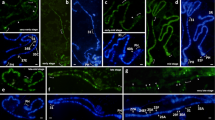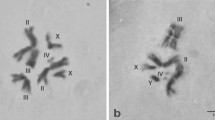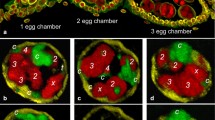Summary
-
1.
In salivary gland chromosomes of Drosophila melanogaster approximately 70 puffs have been registered. Those of the tip of the X-chromosome and of the chromosome arm IIIL have been investigated in detail.
-
2.
Puffs have been found during all investigated ages, i. e. the last 24 hours of the 2-day third larval instar and the following 12-hour prepupal stage. Puffs are, however, most numerous during two distinct puffing periods, one at the end of each stage. Both periods are alike in that (a) each one extends over not more than six hours, mainly before, but also during and possibly slightly after entering the next developmental stage, (b) puffs are formed in specific chromosome sections, and (c) formation and disapparance of the puffs follows a characteristic order. Both periods differ in that (a) some puffs appear in only one of the two periods, and (b) the other puffs appear in both periods, but in a different order in each one.
-
3.
There is some evidence for a puffing period also at the end of the second larval instar. This, together with the observations of paragraph two suggests that puffing in salivary gland chromosomes is closely connected with the molting from one developmental stage to the next.
-
4.
The view given in paragraph three is supported by puff formation in larvae of the mutant giant (gt), whose third larval instar may be three times as long as normal. In spite of this prolongation their puffs are also formed at the end of this instar, identical in place and sequence with puffs of normal third instar larvae.
-
5.
Salivary gland chromosomes of another mutant, lethal-giant-larvae (lgl), on the other hand, do not develop typical puffs before or at the time of their puparium formation that occurs up to 14 days later than in their normal sisters. The independance of puffing and puparium formation in this case does not, however, necessarily contradict a possible interdependance of them in normal development, since the salivary glands of this mutant are abnormal in their growth.
-
6.
Both salivary glands were removed from normal larvae. One of each pair was fixed immediately, while the remaining partners were kept for different intervals in Ringer's solution. Depending on the ages of the larvae, three different types of puffing behavior in the second gland have been observed. Glands of larvae younger than a certain stage of the third larval instar showed a surprising reverse development of their puffing pattern; glands of larvae older than this stage went on with the development of their puffing pattern almost normally; and glands of larvae at precisely the pivotal stage showed in different cells different kinds of development: some developed in the reverse, others in the forward direction and still others showed abnormal puff combinations. These latter ones showed in addition a puff in subsection 67C that has not been found otherwise.
-
7.
A difference between the anterior and the posterior part of the gland was found in the puffing behavior of X-chromosome subsection 15BC, which forms a typical puff only in the anterior part.
-
8.
The results are discussed in connection with current interpretations of the puffing phenomenon.
Similar content being viewed by others
Literatur
Beermann, W.: Chromomerenkonstanz und spezifische Modifikationen der Chromosomenstruktur in der Entwicklung und Organdifferenzierung von Chironomus tentans. Chromosoma (Berl.) 5, 139–198 (1952a).
—: Chromosomenstruktur und Zelldifferenzierung in der Speicheldrüse von Trichocladius vitripennis. Z. Naturforsch. 7b, 237–242 (1952b).
—: Nuclear differentiation and functional morphology of chromosomes. Cold Spr. Harb. Symp. quant. Biol. 21, 217–232 (1956).
—: Chromosomal differentiation in insects. In Developmental Cytology, p. 83–103. Ed. by D. Rudnick. New York: Ronald Press Comp. 1959.
Breuer, M. E., and C. Pavan: Salivary chromosomes and differentiation. Proc. 9. Internat. Congr. Genet. Part II, Caryologia (Firenze) 6, Suppl. 778 (1953).
—: Behavior of polytene chromosomes of Rhynchosciara angelae at different stages of larval development. Chromosoma (Berl.) 7, 371–386 (1955).
Bridges, C. B.: Salivary chromosome maps. With a key to the banding of the chromosomes of Drosophila melanogaster. J. Hered. 26, 60–64 (1935).
— A revised map of the salivary gland X-chromosome of Drosophila melanogaster. J. Hered. 29, 11–13 (1938).
-, and K. S. Brehme: The mutants of Drosophila melanogaster. Carnegie Inst. Publ. 552 (1944).
Gabritsohevsky, E., and C. B. Bridges: The giant mutation in Drosophila melanogaster. II. Z. indukt. Abstamm.- u. Vererb.-Lehre 46, 248–284 (1928).
Grob, H.: Entwicklungsphysiologische Untersuchungen an den Speicheldrüsen, dem Darmtraktus und den Imaginalscheiben einer Letalrasse (lgl) von Drosophila melanogaster. Z. indukt. Abstamm.- u. Vererb.-Lehre 84, 320–360 (1952).
Hadorn, E.: Role of genes in developmental processes. In: The Chemical Basis of Heredity, p. 779–793. Ed. by McElroy u. Glass. Baltimore: Johns Hopkins Press 1958.
Mechelke, P.: Reversible Strukturmodifikationen der Speicheldrüsenchromosomen von Acricotopus lucidus. Chromosoma (Berl.) 5, 511–543 (1953).
Oster, I. I.: Factors bearing on the nonmalignancy of tumors in Drosophila. Cancer Res. 14, 478–481 (1954).
Painter, T. S.: The morphology of the third chromosome in the salivary gland of Drosophila melanogaster and a new cytological map of this element. Genetics 20, 301–326 (1935).
Pavan, C., and M. E. Breuer: Differences in nucleic acid content of the loci in polytene chromosomes of Rhynchosciara angelae according to tissues and larval stages. Symp. “Cell Secretion”, Belo Horizonte, Brasilien, p. 90–99, 1955.
Rudkin, G. T.: The ultraviolet absorption of puffed and unpuffed homologous regions in the salivary gland chromosomes of Drosophila melanogaster. Genetics 40, 593 (1955).
Swift, H., and E. M. Rasch: Composition and structure of giant chromosomes. Int. Rev. Cytol. 3, 170–171 (1953).
Author information
Authors and Affiliations
Rights and permissions
About this article
Cite this article
Becker, H.J. Die Puffs der Speicheldrüsenchromosomen von Drosophila Melanogastee . Chromosoma 10, 654–678 (1959). https://doi.org/10.1007/BF00396591
Received:
Published:
Issue Date:
DOI: https://doi.org/10.1007/BF00396591




